Waves are part of our world as both waves in the ocean and radio waves coming in from the Sun’s corona share fundamental properties.[i] Wireless communication was born from the science of waves and how they travel. After more than a hundred years of study, we’ve organized waves into a large electromagnetic spectrum (EM) that is classified by frequency.
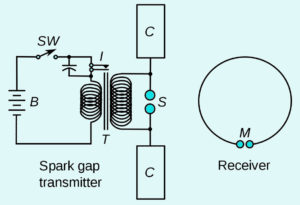
Wavelength and frequency are related:
λ f =c
where λ is wavelength, f is frequency, and c is the speed of light.[ii] Frequency tells us how many wave peaks pass through a fixed position across an interval of time. Many frequencies are channels used to carry signals, creating an entire spectrum that varies from signals with very long wavelengths to the very short.
How did the spectrum come to be?
What Hertz discovered
Wireless technology began over a hundred years ago. Heinrich Rudolf Hertz (1857-1894) was a brilliant German experimental physicist who proved that electromagnetic waves exist, as predicted by James Clerk Maxwell’s (1831-1879) electromagnetic field theory. In 1888, Hertz ferreted out what would someday be called “radio waves.” Hertz employed an apparatus (Figure 1) using a zinc sheet to demonstrate “evidence of a standing wave that can only have been formed by a traveling wave combining with its reflection from the zinc screen.”[iii]
Over his short life, Hertz carried out a series of extraordinary experiments demonstrating noteworthy properties of the waves that he detected. Like light waves, Hertz’s waves could be polarized, reflected, and refracted. Hertz identified waves of a wavelength that falls within the radio spectrum, which is a part of the much larger Electromagnetic (EM) Spectrum (organized as pictured in Figure 2).
We define wavelength as the “distance between adjacent points of the electromagnetic wave that are in equal phase (e.g., wave crests).”[iv] The wavelength of visible light is between 3.8×10– 7 and 7.6×10-7 (see Table 1). However, Hertz had discovered wavelengths much larger than visible light waves, on the order of > 0.3 meters. Hertz passed away in his late thirties with a condition that’s treatable with steroids today. The American Association for the Advancement of Science (AAAS) christened the unit as “one cycle per second,” or a “Hertz” in Hertz’s honor.[v]
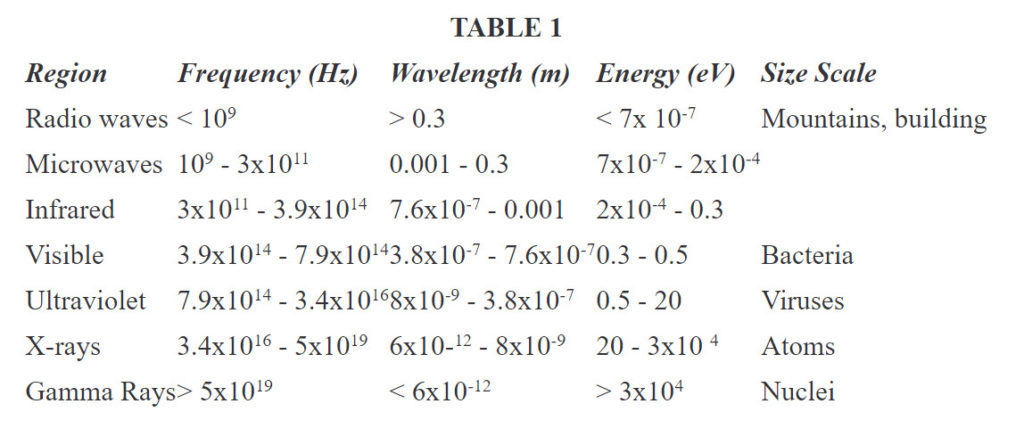
There are nine bands that the National Telecommunications and Information Administration has organized within the radio spectrum (Figure 2). Waves of different frequencies exhibit different capabilities with varying advantages. For example, waves propagating at frequencies higher than 10 GHz have to worry more about attenuation; that is, being weakened by rain, fog, sleet, snow, and gaseous absorption (caused by oxygen and water vapor.)[vi] The majority of cellular systems keep to a “safe zone” in the spectrum by using frequencies below 6 GHz. Frequencies below 6 GHz translate to good coverage despite atmospheric variations. Although adjusting for weather conditions is usually “not part of initial system design,”[vii] carriers such as Verizon note, “Severe weather and seasonal conditions like heavy snow, storms or even trees in bloom can also affect [coverage].”[viii]
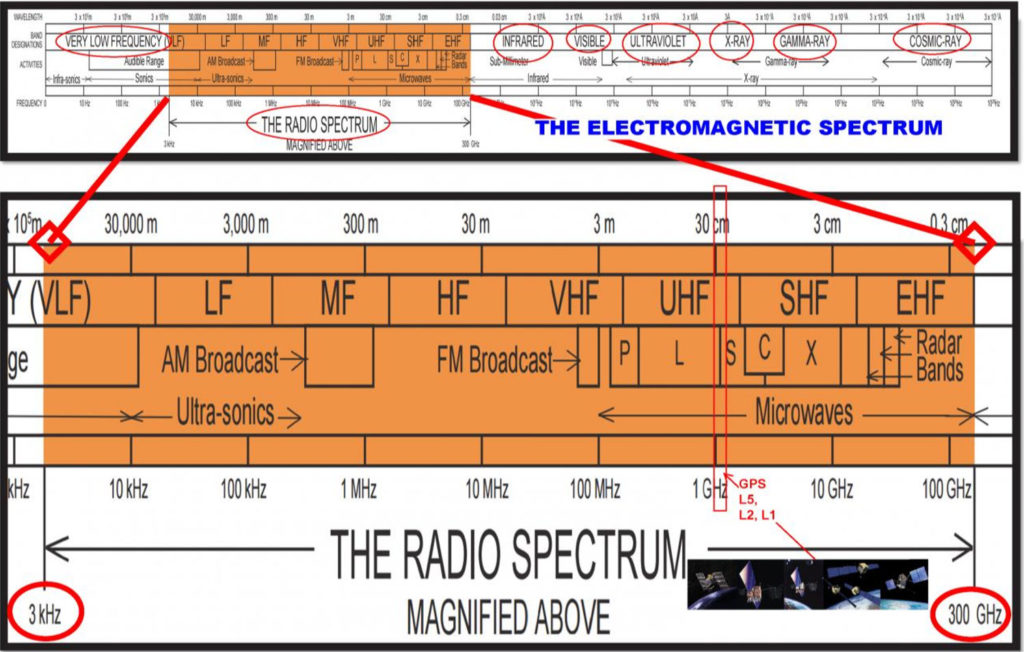
The atmospheric effects at frequencies greater than 6 GHz factor into wireless system design. Design at greater than 6 GHz must take into account how backhaul reacts. (Backhaul is defined as the “intermediate links between the core network, or backbone network, and the small subnetworks at the edge of the network.”[i]) A key enabler of 5G network backhaul links can be tens of miles long.
When gaseous absorption (noted earlier) influences backhaul and other wireless system components, it’s the water vapor or oxygen molecules, which have specific frequencies of resonance, that cause peaks of absorption around affected frequencies. The absorption peak for water vapor is around 24 GHz (and multiples thereof), with 60 GHz being the main peak for oxygen.[ii]
One situation causing ample concern is heavy rain comprised of large-sized raindrops. Should rainfall be in the “cats’ and dogs’” realm of two- to four-inches an hour, a 10-20dB/km attenuation could take place, causing radio outages for both Local Multipoint Distribution Systems (i.e., LMDS at 28 GHz) or point-to-point microwave links (at 6, 11, 18, and 23 GHz).[iii]
Rules and differences
The EM spectrum, although intangible and invisible, is a resource. Rules and regulations governing the spectrum set conditions for coordination and guide each of the nine bands,[iv] primarily to avoid interference for competing services that are using the same spectrum in the same location.
While the need for rules applies to all the bands, the properties and applications for each band are not homogeneous. Waves in the lower part of the spectrum are used for TV and radio broadcasting, getting their start with scientists like Guglielmo Marconi (1874-1937) making “the leap from Hertz’s lab experiments to practical wireless telegraphy using electromagnetic waves as the medium of communication.”[v] Waves propagating at lower frequencies are also useful for mobile applications. Applications requiring higher throughput can capitalize on the generous amount of higher spectrum that’, but waves with a higher frequency are more influenced by atmospheric effects and need “near line-of-sight conditions.”[vi] Avoiding the need for line-of-sight or nearly line-of-sight made a success of Marconi’s invention of mobile communications using ships traversing the English Channel. Marconi sent the first successful radio transmission thousands of miles across the Atlantic Ocean, as radio signals bounced off the ionosphere to reach the next ship in spite of the curvature of the earth.
In recent history, the spectrum, although intangible and invisible, has been sold with intense competition as a resource. Excessive bidding on carrier frequencies in the spectrum, combined with costly satellite services and a few premature broadband wireless objectives triggered both failures and bankruptcies around 2000. Nevertheless, wireless communication has grown continuously as technology has persistently improved. Continued growth will come as a result of a hearty appetite for data use and the proliferation of new applications, including the Internet of Things (IoT).
Hints of our wireless future
Innovative wireless solutions cover the spectrum, aided by microcontrollers and other devices. Many new applications could someday result from activity encouraged by the Federal Communications Commission’s (FCC) recent proposal to “make a massive 21.2 gigahertz of spectrum above 95 GHz available for unlicensed use across four frequency bands.”[vii] In February 2019, Ajit Pai, FCC Chairman, states that he is “…also proposing to add a new experimental license type that would that would permit experimental use on any frequency from 95 GHz to 3 THz, with no limits on geography or technology.” Pai goes on to say, “We currently don’t know precisely what types of applications and wireless services the laws of physics will permit in these bands…..The history of wireless innovation is one of government creating space for broad thinking and entrepreneurs using that space to take us in unexpected directions. With this order, we’ll set up a big sandbox for engineers and technologists to work with — and we’ll then see what American ingenuity delivers.”
[i] https://en.wikipedia.org/wiki/Backhaul_(telecommunications)
[ii] http://morse.colorado.edu/~tlen5510/text/classwebch1.html#x5-40001
[iii] Ibid.
[iv] Ibid.
[v] Raboy, Marc. Marconi: The Man Who Networked the World. New York: Oxford University Press, 2016, 54.
[vi] http://morse.colorado.edu/~tlen5510/text/classwebch1.html#x5-40001
[vii] https://www.fcc.gov/news-events/blog/2019/02/21/behold-ides-march
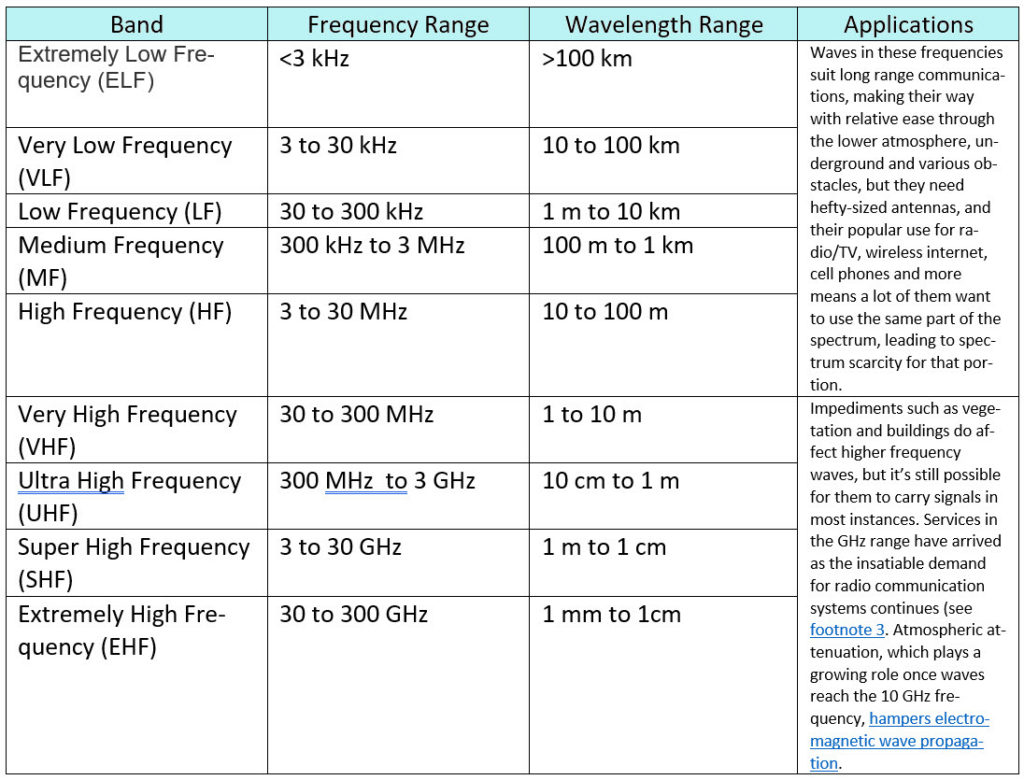


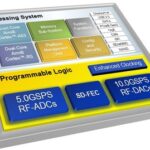

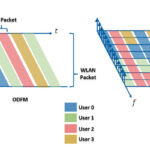
Leave a Reply